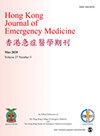Does respiratory variation in inferior vena cava diameter predict fluid responsiveness in adult patients? A systematic review and meta-analysis of diagnostic accuracy studies
IF 0.8
4区 医学
Q4 EMERGENCY MEDICINE
引用次数: 0
Abstract
Objectives: To systematically review the diagnostic utility of the respiratory variation of the inferior vena cava diameter measured using ultrasonography for predicting fluid responsiveness in adult patients and compare the three commonly used equations, inferior vena cava distensibility, inferior vena cava collapsibility and inferior vena cava variability. Methods: We searched PubMed, Scopus, Web of Science and Cochrane library, and included studies investigating the diagnostic accuracy of the respiratory variation of the inferior vena cava measured using ultrasonography compared to a reference standard for measuring cardiac output after a fluid challenge for fluid responsiveness, and stratified participants as fluid responsive or not. We included studies conducted in the emergency department or intensive care unit. We excluded studies on paediatric, prehospital, cancer, pregnant, dialysis patients or healthy volunteers. Results: We retrieved 270 records and excluded 171 because of irrelevance, patient population or publication type. We screened the abstracts of 99 studies and then the full texts of 42 studies. Overall, 21 studies with 1321 patients were included, of whom 689 (52%) were fluid responsive. The mean threshold value for positive inferior vena cava distensibility, inferior vena cava collapsibility and inferior vena cava variability was 17%, 35% and 12%, respectively. The heterogeneity between studies was high. Bivariate diagnostic random-effects meta-analysis was used to calculate the summary receiver operating characteristics curves. The overall accuracy, sensitivity and specificity of respiratory variation of the inferior vena cava diameter were 0.85, 0.72 and 0.81, respectively. The accuracy of inferior vena cava distensibility and inferior vena cava collapsibility was similar. The diagnostic utility of respiratory variation of the inferior vena cava diameter was lower but not statistically significant in mechanically ventilated patients compared with spontaneous breathing for predicting fluid responsiveness. Conclusion: The respiratory variation of the inferior vena cava diameter has moderate diagnostic utility for predicting fluid responsiveness independent of the equation used.下腔静脉直径的呼吸变化能否预测成人患者的液体反应性?诊断准确性研究的系统回顾和荟萃分析
目的:系统回顾超声测量的下腔静脉直径呼吸变异在预测成年患者液体反应性中的诊断作用,并比较三个常用方程,下腔静脉扩张性、下腔静脉塌陷性和下腔静脉变异性。方法:我们搜索了PubMed、Scopus、Web of Science和Cochrane图书馆,并纳入了研究使用超声测量下腔静脉呼吸变异的诊断准确性的研究,与测量液体刺激后心输出量的参考标准相比,测量液体反应性,并将参与者分为液体反应性或非液体反应性。我们纳入了在急诊科或重症监护室进行的研究。我们排除了对儿科、院前、癌症、孕妇、透析患者或健康志愿者的研究。结果:我们检索了270份记录,并排除了171份,原因是不相关、患者群体或出版物类型。我们筛选了99项研究的摘要,然后筛选了42项研究的全文。总体而言,纳入了21项研究,涉及1321名患者,其中689人(52%)有液体反应。阳性下腔静脉扩张性、下腔静脉塌陷性和下腔静脉变异性的平均阈值分别为17%、35%和12%。研究之间的异质性很高。双变量诊断随机效应荟萃分析用于计算总结的受试者操作特征曲线。下腔静脉直径呼吸变异的总体准确性、敏感性和特异性分别为0.85、0.72和0.81。下腔静脉扩张性和下腔静脉塌陷性的准确性相似。与自然呼吸相比,机械通气患者下腔静脉直径呼吸变化在预测液体反应性方面的诊断效用较低,但在统计学上并不显著。结论:下腔静脉直径的呼吸变化在预测液体反应性方面具有中等的诊断实用性,与所用方程无关。
本文章由计算机程序翻译,如有差异,请以英文原文为准。
求助全文
约1分钟内获得全文
求助全文
来源期刊

Hong Kong Journal of Emergency Medicine
EMERGENCY MEDICINE-
CiteScore
1.50
自引率
16.70%
发文量
26
审稿时长
6-12 weeks
期刊介绍:
The Hong Kong Journal of Emergency Medicine is a peer-reviewed, open access journal which focusses on all aspects of clinical practice and emergency medicine research in the hospital and pre-hospital setting.
 求助内容:
求助内容: 应助结果提醒方式:
应助结果提醒方式:


